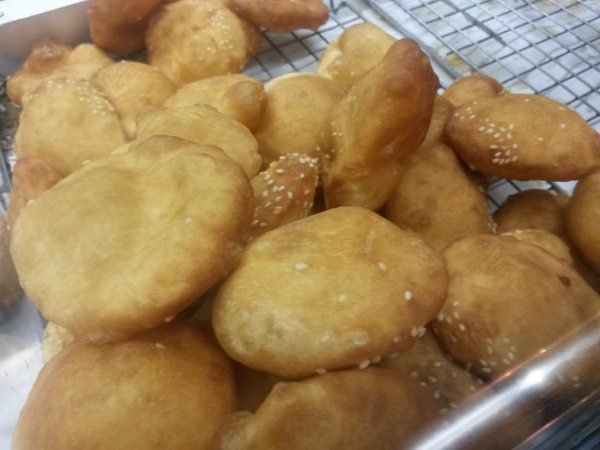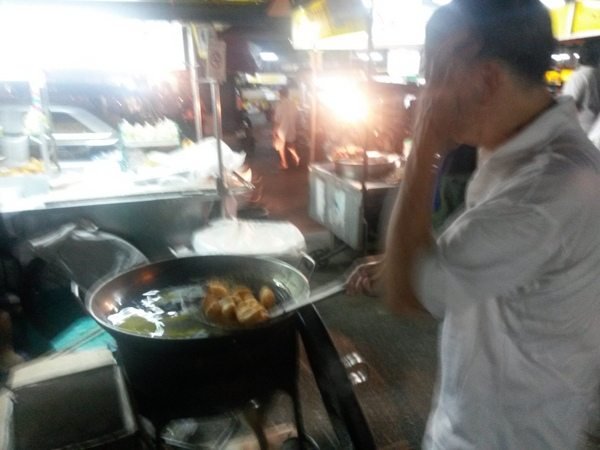Thai Street Food: What’s that Smell?
I love to eat street food and do so without much fear. Trips to China have made me a bit more cautious as food scandals in the newspapers there seem to be way too frequent. Fry oil recycled from the trash (and the heavy metals that come with it) is allegedly more common there than one might expect. Plus there’s that 2008 case of melamine in baby formula that now has most Chinese citizens who can afford it buying imported varieties for their kids. And other incidents.
So maybe that was in the back of my mind when I bit into a Thai street snack and tasted unmistakable chemicals. I was right about the chemical I.D. but wrong to be concerned, but it sent me on a brief educational and enlightening journey to Google.
White, fluffy, steamed buns with a bit of red barbecue pork in them are sometimes referred to as Sala Pao. It’s a popular item in China and has made its way via Chinese immigrants into parts of Southeast Asia, including Thailand. But in Thailand there is another “sala pao,” which is what I would term the Thai donut. Deep-fried dough, slightly sweet, fried up in a kettle right there on the street. (I think I just made a poem. Total accident there.)
Sala pao of the Thai donut variety are served with sang kaya, an optional dipping sauce, often made with condensed milk and pandan leaf for a green coloring. (Like the term sala pao, “sang kaya” may also refer to something slightly different: coconut custard or coconut jam. One of the sources of frustration for me when trying to learn Thai.)
I was in Chiang Mai standing at the Chiang Mai Gate market (South Gate Market), waiting for my smoothie from the famed “Smoothie Lady,” when I get a pretty strong whiff of ammonia. There isn’t much that can be confused with ammonia, especially as getting your nose into it can really mess with a person’s sinuses. I found that a little odd out there in the middle of the street. This was much stronger than a cleaning solvent, but we were standing in a park of sorts. Where would it come from?
I can’t say “terrorist attack” had ever crossed my mind, but thanks Google: “The widespread use of ammonia on farms and in industrial and commercial locations means that exposure can also occur from an accidental release or from a deliberate terrorist attack” from New York Dept of Health But I have to confess it did seem a bit weird and drove my curiosity. Ammonia at the time wasn’t on my list of desired foods.
I took a look around. But it was just the Smoothie Lady and the Thai Donut Guy. We got our drinks, bought our donuts, and went to take a table. I bit into my first warm sala pao and there it was: ammonia right up my nose. What??? Seriously?
Google to the rescue (unless you are a baker and already know all this). It was baker’s ammonia: used in quick breads, it is an old-school leavener (that which makes the bubbles that make a bread rise). Before baking soda, there was Baker’s ammonia (ammonium carbonate), and before that it was Salt of Hartshorn, the ground up antler of a deer. Who, pray tell, figured THAT one out? “You know what this bread needs? Let’s go hunting!”
Normally, the baking (or deep-frying) process gets rid of the ammonia smell and taste, but perhaps my Thai donuts needed a bit more time in the fry oil.
Tic Tac Dough: the X’s and O’s are patongo and sala pao, respectively. The X-shaped fried dough is not sweet and maybe a tad bit salty. You will often see them together, but the X’s are more popular with congee (rice porridge) at breakfast.









 ORDER YOUR COPY TODAY!
ORDER YOUR COPY TODAY! ORDER YOUR COPY TODAY!
ORDER YOUR COPY TODAY!
I am now craving these donuts again, thank-you?
Well, I didn’t want to be the ONLY one. 😉
VERY interesting! I’ve just been reading STIFF by Mary Roach. If deer antler sounds weird as an ingredient, don’t read the chapter entitled “Eat Me”.
I will have to check it out.
Good investigative work here! I had no idea. And glad it all turned out to be harmless, because I ate many of those donuts.
Me too, but I had never smelled ammonia before. I would think most people use baking soda now, but maybe he ran out.
I love me some fried dough with condensed milk. I do think, however, there is better sala pao just east of chiang mai gate at a flavored soy milk (soi milk?) place on the outside of the moat. You have to wait for it, but it’s goooood.
Ah, condensed milk: who knew it was such an awesome condiment/dipping sauce?
We will check out that soy/i milk place next month!
Pingback: Eating the Century Egg
Wow. Just been on google looking for an answer to my doughnuts this morning from koh Lanta Thailand. The smell was so strong it unblocked my nose lol. I ate three and my girlfriend but into hers and spat it out. I must say the taste was not so bad but th smell was so potent even the street dogs turned there noses up at them.
I found in my case that if you bit into it and let it air out it was OK. But pretty impressive, huh?
Yes ammonium bicarbonate is a pain in the …nose. According to research, totally safe for consumption, has been used since flat, crispy, spiced cookies were invented, ergo just about 4ever . Ammonium bicarbonate is used throughout in Germany, Scandinavia – if you like those Springerle cookies for example . Only the original ammonium bicarbonate was *organic*, now it is chemically produced, I think. This link has useful information :
https://www.thespruce.com/ammonium-carbonate-hartshorn-hirschhornsalz-1446913
I’ve used this ingredient and must admit that I sometimes toss the entire lot out because I can’t stand the smell, sometimes I get lucky and there’s not a whiff of it. Don’t ask me … I am still trying to figure out what I did wrong or right? How did you think I stumbled on this post LOL ! I’m researching……
By the way, that kaya green color is almost fluorescent. I couldn’t eat that either 🙁 The natural color from the pandan amaryllifolius leaves (which is one of the staple ingredient for color and fragrance in Kaya) is more of an unattractive green but totally natural. I am a Singaporean living in Germany, I helped my mother make Kaya since I was a toddler. Kaya btw is a malay word meaning rich.
My late mother used the leaves only for their fragrance and not color, our Kaya was a golden yellow/brown. Kaya is made from loads, tons of egg yolk, thick coconut milk and just as much sugar ! Hence KAYA (RICH). It doesn’t help that the traditional way of eating Kaya (in Singapore at least) was on a hopelessly nutrition-less white sandwich slice toasted till it was crispy, preferably on a charcoal grill, with a very thick cold slice of good ol’ butter and a generous spread of kaya on top. I used to call this a very delicious gastronomical version of a *heart attack*.
As for Patongo, another essential ingredient for that is Aluminium powder, at least in the past. This helps those nice crullers (we call them that in english or You Tiao in chinese) for that extra crisp. A good Patongo/cruller has a nice crunchy shell and nothing but air in it ! We consume these by dipping them into strong coffee for breakfast or they are used as a condiment for porridge or as a topping for a sweet split bean soup called Tau Suan. These days alot of Patongo are made with yeast as a leavening agent, which make them turn out more *bready* and only remotely resembling the original You Tiao. Check it out in Google if you care to take this one step further 😀
Sorry about the long post, I had time and couldn’t resist.
Thanks for the interesting further information. Fascinates me!
Thank you SO Much For explaining the source of the ammonia smell. I buy these locally and noted a strong ammonia smell while they are hot which dissipates as they cool, but I was always concerned till now.
Glad it helped! And who knew??